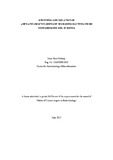Screening and isolation of γ-hexachlorocyclohexane degrading bacteria from contaminated soil in Kenya
Abstract
The organochlorine insecticide Lindane is the γ-isomer of hexachlorocyclohexane
(HCH). It is among the most distributed and frequently detected organochlorine
pollutants in the environment. Consequently it has been flagged down for regulatory
intervention and efforts are being made to eliminate it from the environment. Among
the approaches proposed, bioremediation has been put forward as a promising
environmental friendly approach. In line with this mission, the aim of this work was
to isolate and identify bacteria able to utilize Gamma-1, 2,3,4,5,6hexachlorocyclohexane
(γ-HCH) as a sole carbon source, and thus potential
bioremediation agents. Using soil sample collected from a site contaminated with
organochlorine pesticide, three isolates identified by 16S rRNA gene sequencing as
Achromobacter sp. (isolate 1 and isolate 3) and Stenotrophomonas sp. (isolate 2) were
observed to grow in minimal salt media containing γ-HCH as the sole carbon. They
were all observed to be gram-negative rods that formed circular convex shaped
colonies on nutrient agar. Their optimal growth temperature and pH was found to be
37 oC and 7 respectively. Growth of these isolates in minimal salt media containing γHCH
as the sole carbon source after 10 days indicated reductions of γ-HCH by 84%,
35% and 51% in Isolates 1, 2 and 3 respectively. The three isolates are being reported
for the first time as able to degrade γ-HCH. In the future, these microorganisms
should be further investigated to establish the pathway and extent to which they
degrade γ-HCH. In addition to this, their potential to degrade other persistent
organochlorine insecticides and HCH isomers could be evaluated. This will be helpful
in determining their potential use as non-polluting bio-agents that rapidly detoxify
and/or mineralize recalcitrant and obsolete chlorinated organic pesticides.
Publisher
University of Nairobi

